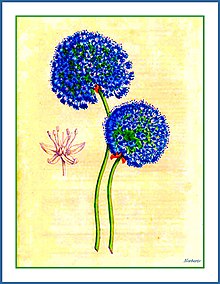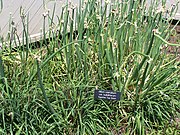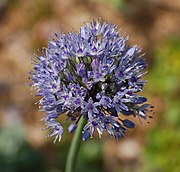bio.wikisort.org - Plant
Allium caeruleum (blue globe onion, blue ornamental onion, blue-of-the-heavens, blue-flowered garlic; syn. Allium azureum Ledeb.) is an ornamental bulbous plant of the onion genus, native to Central Asia (Kazakhstan, Kyrgyzstan, Siberia, Tajikistan, Uzbekistan, and Xinjiang).[3][4][5] In these regions, it is found on dry slopes, plains, and steppes.[6]
| blue-of-the-heavens Лук голубой 棱叶薤 leng ye xie | |
|---|---|
 | |
| 1847 illustration[1] | |
| Scientific classification | |
| Kingdom: | Plantae |
| Clade: | Tracheophytes |
| Clade: | Angiosperms |
| Clade: | Monocots |
| Order: | Asparagales |
| Family: | Amaryllidaceae |
| Subfamily: | Allioideae |
| Genus: | Allium |
| Species: | A. caeruleum |
| Binomial name | |
| Allium caeruleum Pall. | |
| Synonyms[2] | |
| |
This plant is cited in the Flore des Serres et des Jardins de l'Europe puis L'illustration horticole by Charles Antoine Lemaire. It grows to 80 cm (31"), producing strap-shaped leaves and small globes (umbels) of blue flowers in early summer. The one-inch wide globular flower heads attract butterflies.[7] The plant has been granted the British Royal Horticultural Society's Award of Garden Merit (1993).[8]
A. caeruleum thrives in well-drained soil in full to partial sun.[9] It is deer-resistant and suitable for USDA hardiness zones 4–8.[6]
Gallery
- Allium caeruleum var. bulbilliferum Egyptian Top Onion at Minnesota Landscape Arboretum
- Flower head closeup
References
- illustration from Flore des serres et des jardins de l’Europe by Charles Lemaire and others. Gent, Louis van Houtte, 1847, volume 3 (plate 300).
- The Plant List
- "NC State University: Allium caeruleum". Archived from the original on 2007-07-04. Retrieved 2007-04-06.
- Flora of China Allium caeruleum 棱叶薤 leng ye xie
- Peter Simon von Pallas. 1773. Reise durch verschiedene Provinzen des russischen Reichs 2: 727, pl. R.
- "Allium caeruleum - Plant Finder". www.missouribotanicalgarden.org. Retrieved 2021-05-17.
- "Allium caeruleum (Ornamental Onion)". Gardenia.net. Retrieved 2021-05-17.
- "Allium caeruleum AGM". RHS Plant Finder. Royal Horticultural Society. Archived from the original on 18 March 2014. Retrieved 27 July 2013.
- "Boston Bulbs Wholesale - Allium Azureum Bulbs - Boston Bulbs Wholesale". www.bostonbulbswholesale.co.uk. Retrieved 2021-05-17.
На других языках
- [en] Allium caeruleum
[ru] Лук голубой
Лук голубой (лат. Allium caeruleum) — вид многолетних травянистых растений рода Лук (Allium) семейства Амариллисовые (Amaryllidaceae).Другой контент может иметь иную лицензию. Перед использованием материалов сайта WikiSort.org внимательно изучите правила лицензирования конкретных элементов наполнения сайта.
WikiSort.org - проект по пересортировке и дополнению контента Википедии


